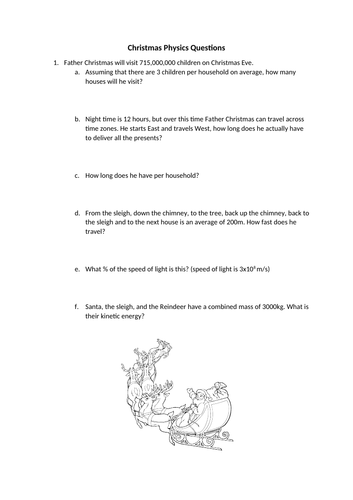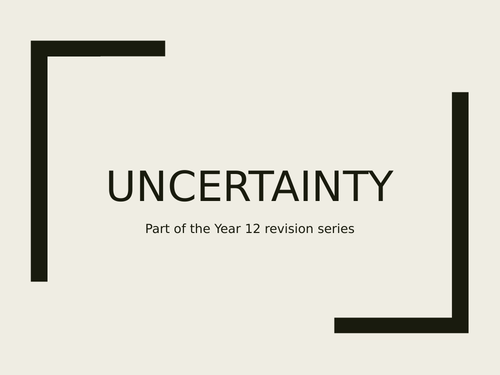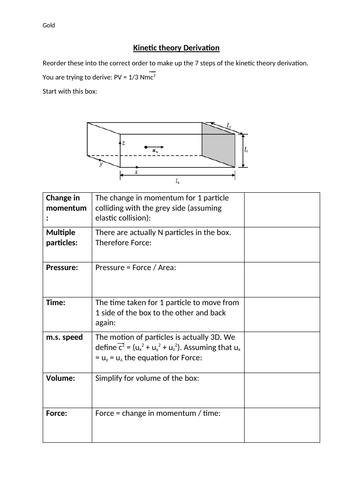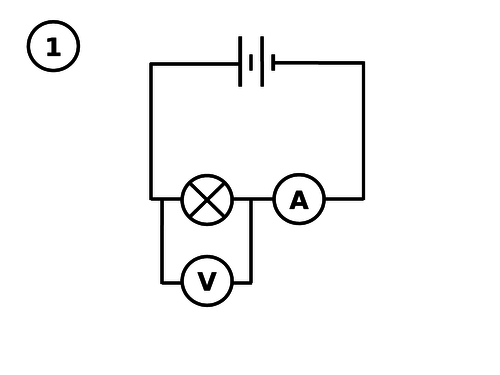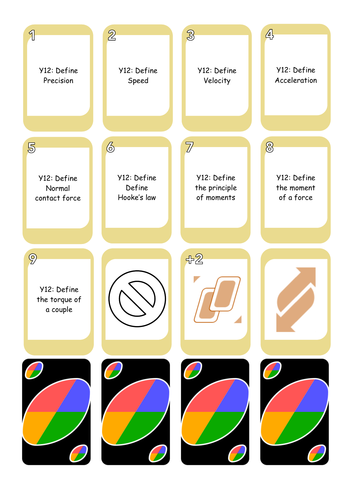
87Uploads
60k+Views
11k+Downloads
All resources

Physics equations help sheet
I use this as a poster, but this could also be shared with pupils.
The sheet gives advice about how to answer equation questions including using prefixes required for GCSE.

Investigating speed of a toy car - analysing experiments and drawing graphs homework sheet
This worksheet is designed for use in a lesson or as a homework, to teach about analysing experiments and using data.
The worksheet describes an experiment to find the speed of a toy car. Pupils have to state the independent, dependent and control variables. They have to identify outliers/anomalies , calculate averages, plot a graph of results, and write a conclusion.
Includes an extension to the task - evaluation of the method.
I like to use this as a homework after conducting a similar experiment in class.
Answer sheet is also included.

How to Draw a Graph in Excel - Practical endorsement
A how-to guide for drawing a line graph in Excel.
This includes range bars and can therefore be used for creating graphs used during practicals up to A-level.
I use this for my A level groups during one of the required practicals. This could be used for CPAC 5 to show data processing through software.

Christmas Worksheet Science: Physics: Energy and Electricity
Some Christmas questions based on Physics knowledge, with answers.
This includes questions on:
Speed equation
Electrical power
Voltage, current and resistance
GPE
KE
Work done
Thermal energy transfers
Designed for Year 10 or 11.
Merry Christmas!

Finding the Planck constant using Photoelectric Simulation
This worksheet allows pupils to use the stopping potential and wavelength found using the Photoelectric effect simulation, to draw a graph of kinetic energy against frequency and find a value for the Planck constant. They could also find the work function of the material using the y-intercept.
There is even a past paper question linked to the practical to encourage them to think about uncertainty.

Uncertainty in experiments
A summary of the Section 1 - Measurements and Their Errors topic on the AQA Physics A-level course.
Content will apply across different exam boards and includes the following:
SI Units
Calculating Uncertainty using precision
Calculating Uncertainty using range
Calculating Uncertainty using worst line of best fit.
Combining uncertainties.
Each includes some practice questions, and the answers are included int eh comment box in PPT.
I used this as part of revision in preparation for A level exams.

Hubble's law and the Redshift equation
A worksheet allowing pupils to calculate recessional velocity using the change in wavelength of spectral lines from stars.
This focuses on using the v/c = change in wavelength / wavelength equation.
After answering the 5 questions, pupils can conclude that the more distant the galaxy, the faster it is moving, which makes a great introduction to redshift and the Big Bang Theory.
There is an extension task to plot the recessional velocity against distance, calculate Hubble’s constant and calculate the age of the Universe.
If calculated correctly, pupils should conclude that the Universe is 13.8 billion years old.
Answers included.
The extension task is a great way to stretch and challenge the most able at GCSE, while the main task allows weaker pupils to practice using the Doppler shift redshift equation.
This could also act as a nice task for A-level pupils, studying Hubble’s law.

Kinetic Theory Derivation
Deriving the PV = 1/3 Nmc2 equation in 7 simple steps.
Pupil either follow the rules to derive the equation, or (for higher level challenge) reorder the steps, then fill them in.
This is a derivation that they are required to know and this is designed to simplify a complex idea!
Please review.

Particle motion in a gas crossword
A crossword puzzle on motion of particles in a gas. This includes the idea that gases cause pressure, and the effect of temperature.

Braking forces worksheet - Work done against friction
A worksheet on braking forces. These reinforce the Work done equation as pupils calculate the stopping distance for cars moving at different speeds.
There are also some questions on where the energy goes and the affect of speed on braking distance.
Answers are also included.

Light 'Em Up - The circuits board game
A game based on Battle ships. (Alternative name: Bulbs and Batt(ery) ships?)
“Ammeter on A3”
“Voltmeter from B1 to B3”
I used this as an entire lesson’s activity, pitting my students against each other in a knock out tournament. The game reinforces and assesses their knowledge of voltage and current in series and parallel. It can be adapted to differentiate by giving them suggested boards and including some numbers. I’ve included a cheat sheet page for this purpose.
How to set up:
Design your board.
Work out the voltage and current at different points on your board.
How to play:
The aim of the game is to correctly draw your opponent’s circuit. On your go, choose a square and ask for the current, or choose 2 squares and ask for the voltage across them. Your opponent has to be honest and correct! You can ask 1 question per go and take it in turns until someone can correctly draw the circuit.
Teacher instructions:
Pupils should be in pairs or 4s to play this game.
Each group will need 2 game boards, 2 sets of tokens and 2 answer sheets.
I suggest printing and laminating the game board page and cutting out the tokens, and then printing disposable answer sheets for them to draw and scribble on. You could even use Velcro on the back of the tokens so that they stick to the board.

Specific heat capacity puzzle
A Tarsia puzzle on Specific heat capacity. Includes units, and equation questions to test concept and maths.
Works well as a class competition, or would make a nice display.
Pupils cut out puzzle pieces to complete one each I’ve included a solution as well.

Synoptic Question dice for A-level Physics
A set of dice for making synoptic questions. Print on card, give A-level Physics students 2 dice each to build. When finished, they should roll the dice and write a question combining the two topics. They can then roll again!
It’s a great way of getting them into the head of the examiner and preparing them for questions pulling from lots of different topics.

Kirchhoff's whispers (a circuit building game)
Put pupils into 6 groups at 6 stations round the room.
Pupils are given a card with a circuit diagram on it, they must build the diagram and then flip over the card.
At the next station, they have to draw the circuit diagram and then take apart the circuits.
At the next station they have to build the circuit based on the diagram they see, then throw away the diagram.
They game continues for as long as you want it to!
This assesses and develops their circuit building and drawing skills.
It also shows them why it's so important to draw circuit diagrams carefully.
I've printed this double sided, then laminated so that they can draw the circuit on the back in whiteboard pen.
Enjoy!
Please review!

phUNO - the A-level Physics definition card game
Basically the same as the card game with a similar name, but this time, to play a card, you must correctly define the term on the card.
Forces students to learn their definitions. Works well as a revision activity game, or as a Christmas or Summer activity!
Just print, laminate and cut.
Includes Answer sheet.
The cards are also split into Year 12 and Year 13 definitions based on the AQA Physics spec, but these could easily be ignored.
I've also included an editable version.
Bundle

Bitesize Physics Revision worksheets (Electricity, energy, waves and motion)
Please Review!
These are worksheets in a series made to summarise and recap topics from GCSE Physics. Some have two versions for dual award and separate scientists.
All worksheets are based on BBC bitesize pages with the same name, with a QR code to guide students to the correct page. All the answers to the front page can be found there.
There is then a 15 mark exam-style question to test their new knowledge. Every worksheet in the series is out of 15 so students can track their progress. I’ve used them with year 11, and set them as homework, that way they are forced to revise early!
This is designed to help revise for the Edexcel iGCSE in Physics, but is fairly universal and should fit with any exam board.
Includes PDFs for easy printing, and word documents for editing.
There are also series for energy, waves and motion which can be bought separately.
Bundle

Bitesize Waves revision
These are worksheets in a series made to summarise and recap topics from GCSE Physics. Some have two versions for dual award and separate scientists.
All worksheets are based on BBC bitesize pages with the same name, with a QR code to guide students to the correct page. All the answers to the front page can be found there.
There is then a 15 mark exam-style question to test their new knowledge. Every worksheet in the series is out of 15 so students can track their progress. I've used them with year 11, and set them as homework, that way they are forced to revise early!
This is designed to help revise for the Edexcel iGCSE in Physics, but is fairly universal and should fit with any exam board.
Includes PDFs for easy printing, and word documents for editing.
There are also series for electricity energy, waves and motion. There's also a bundle with all 10, thats 10 weeks of revision homework sorted.
Please review!
Bundle

Bitesize Energy revision
These are worksheets in a series made to summarise and recap topics from GCSE Physics. Some have two versions for dual award and separate scientists.
All worksheets are based on BBC bitesize pages with the same name, with a QR code to guide students to the correct page. All the answers to the front page can be found there.
There is then a 15 mark exam-style question to test their new knowledge. Every worksheet in the series is out of 15 so students can track their progress. I've used them with year 11, and set them as homework, that way they are forced to revise early!
This is designed to help revise for the Edexcel iGCSE in Physics, but is fairly universal and should fit with any exam board.
Includes PDFs for easy printing, and word documents for editing.
There are also series for energy, waves and motion. There's also a bundle with all 10, thats 10 weeks of revision homework sorted.
Please review!
Bundle

Bitesize Electricity Revision
These are worksheets in a series made to summarise and recap topics from GCSE Physics. Some have two versions for dual award and separate scientists.
All worksheets are based on BBC bitesize pages with the same name, with a QR code to guide students to the correct page. All the answers to the front page can be found there.
There is then a 15 mark exam-style question to test their new knowledge. Every worksheet in the series is out of 15 so students can track their progress. I've used them with year 11, and set them as homework, that way they are forced to revise early!
This is designed to help revise for the Edexcel iGCSE in Physics, but is fairly universal and should fit with any exam board.
Includes PDFs for easy printing, and word documents for editing.
There are also series for energy, waves and motion. There's also a bundle with all 10, thats 10 weeks of revision homework sorted.
Please review!

Revision tracker
This is a tracker designed for use with revision summary and exam sheets. Find them in my shop, there are 14 in total across the following topics:
Electricity
Waves
Energy
Forces/Motion
They are a series made to summarise and recap topics from GCSE Physics. Some have two versions for dual award and separate scientists.
All worksheets are based on BBC bitesize pages with the same name, with a QR code to guide students to the correct page. All the answers to the front page can be found there.
There is then a 15 mark exam-style question to test their new knowledge. Every worksheet in the series is out of 15 so students can track their progress. I've used them with year 11, and set them as homework, that way they are forced to revise early!
This is designed to help revise for the Edexcel iGCSE in Physics, but is fairly universal and should fit with any exam board.
Includes PDFs for easy printing, and word documents for editing.




